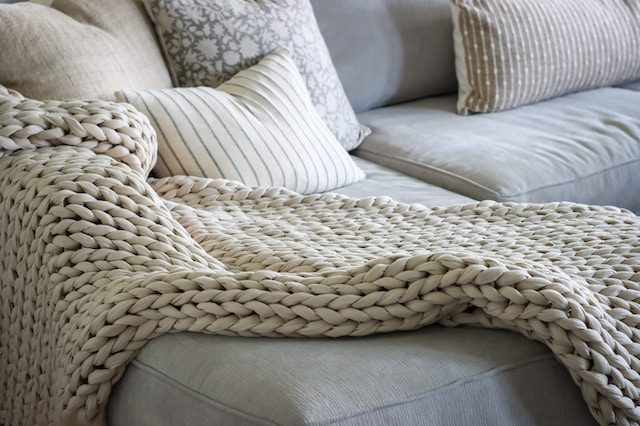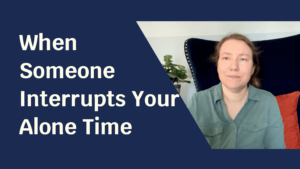Use what you already have
I’ve bought weighted blankets and official fidgets, but a lot of what I use to support my sensory needs are things that I’ve scrounged and repurposed from stuff I already have or could find cheaply.
For example: I had a pretty ceramic bowl lying around from ages ago and poured some salt in it. I like swirling the salt around with my fingers, making different patterns. It makes a slight susurration, which is pleasant. I sometimes add a few drops of essential oils and it releases a pleasant scent for a day or two, especially when moved around.
Small children’s wooden blocks are another example. I like rubbing these around in my hands or squeezing the hard edges into my palms.
If you can’t afford an official weighted blanket, old crocheted or knitted blankets and quilts are often really heavy, especially if they’re large enough to fold in half. Do you have an old crocheted afghan or quilt lying around? Or would an elderly relative love to pass down a sentimental possession? If not, you might find one for cheap at estate sales, garage sales, or secondhand stores.
If it’s dusty or musty, try washing it with a few drops of your preferred essential oils (I prefer lemon).
Or, if you’re crafty and have the time and energy, you might sew an oversized pillowcase or duvet cover style encasement for it out of some old sheets. Basically, just put two sheets together, sew them around three edges, then turn it inside out to keep the seams on the inside. As an added bonus, you will only have to wash the cover instead of the whole, heavy blanket, which can be hard on domestic washing machines.
On the topic of essential oils, some blends can help alleviate motion sickness. I’ve used this one for years.
By the way, the quality of essential oils, scented candles, incense, perfumes, and cologne makes a big difference. If you react to many smells, like I do, it may be worth trying essential oils, as most commercially available scented products are chemical reproductions and not the scent of the actual thing, unlike essential oils. Also, about scented candles, most are made of paraffin wax, but switching to beeswax may make a difference if you tend to get headaches. These higher quality alternatives don’t generally fall into the “cheap” category, but it may be worth keeping in mind.
Nail scrub brushes can replace official Wilbarger protocol brushes for brushing your skin.
Various fabrics you find around the house can provide different textures to rub or handle; look for smooth, soft, rough, etc. depending on your personal preferences.
The kind of headphones construction workers use are a cheap intro to dampening noises. They’re not as good as active noise cancellation, but are soooooo much cheaper and still an improvement in noisy places.
There are apps for your existing smartphone that can play white noise, pink noise, brown noise, etc. to cancel out certain types of noise. Here’s an overview of the different qualities related to each color.
Screens can be dimmed to reduce eye strain and photosensitivity. If your screen is still too bright, even on the dimmest setting, use an app to lower the brightness even more. On a Mac, I use Dimmer Than Dim.
Writing, and printing, on colored paper instead of white may reduce visual distortions or photosensitivity, but not all colors are equally helpful for everyone. Try a few and see which feels easiest to read for you.
Wearing a hat or visor in fluorescent or brightly lit places may reduce energy drain or headaches.
Those damned lights on every electronic device that let you know it’s on, or plugged in, can be covered with stickers or electrical tape. Electrical tape is very dense so the light doesn’t get through at all, and is very cheap ($1-2 for a roll) at any hardware store, and sometimes comes in a small range of color options, though I personally stick with black.
Lying on the floor may help with proprioceptive grounding.
Standing or sitting on a wobble or balance board may pleasantly increase proprioceptive input that, when lacking, may show up as wiggling or fidgeting. These balance aids may be in the form of a purchased product, or simply a pile of things balanced precariously, like a sturdy book on top of a dense, strong ball.
For pleasant vestibular input: I’ve spent many happy hours watching honey dripping from one end of a closed jar to the other, then turning it over and continuing. Sooo calming.
I hope this has given you some ideas, or at least some inspiration, to repurpose stuff you already have to improve your sensory experience.




